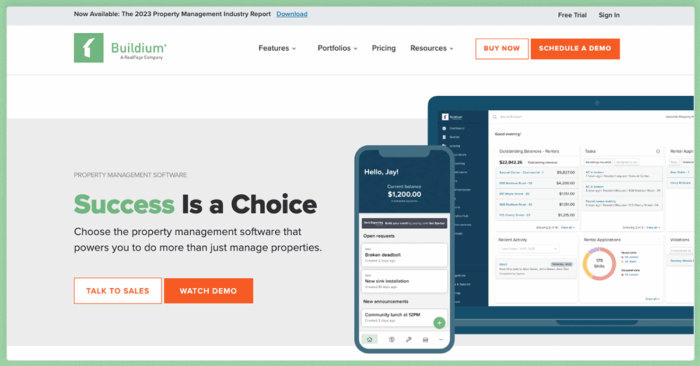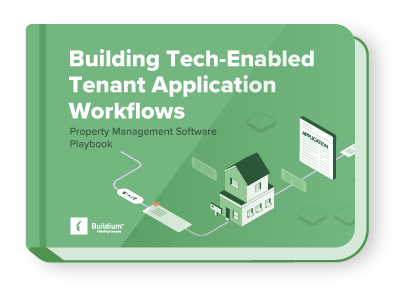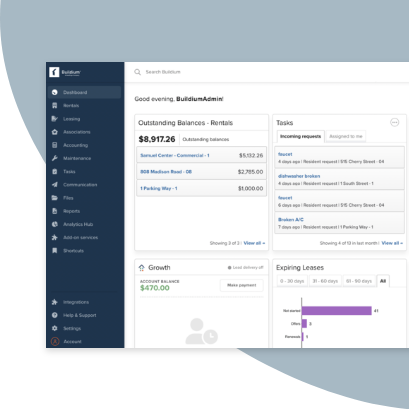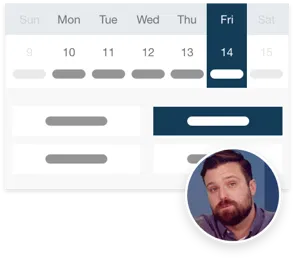Note: RentRedi’s product may have additional features not listed in this article. Please contact RentRedi for more information on their property management software.
If you’re a property manager in 2025, you know that expectations are mounting to deliver ever more convenient services quickly. Tenants expect fast responses, seamless digital experiences, and convenient rent payment options. Meanwhile, owners want to be kept in the loop and get the most value out of any investment they make. Property managers need smarter tools to handle everything from accounting and maintenance to leasing and tenant communication—all while reducing manual workloads.
Two popular software platforms that promise to meet these needs are Buildium and RentRedi. Both offer property management solutions tailored to the industry with tools for different management tasks. But which one is the better fit for your portfolio?
In this detailed comparison, we’ll break down features, pricing, user experience, integrations, and more to help you decide whether Buildium or RentRedi aligns better with your business goals in 2025.
Buildium at a Glance

Buildium is a comprehensive property management solution built for flexibility scalability, with tools to support residential property managers with specialized or mixed portfolios as well as community association managers. Buildium is well-established in the industry but also regularly rolls out new capabilities. Some standout features include:
- A full accounting solution with bank reconciliation and 1099 eFiling
- Online rent collection and tenant portals
- Maintenance tracking with vendor coordination
- Built-in leasing tools, including eLeases and tenant screening
- Marketing and syndication to top rental listing sites
- Communication portals for tenants, owners, and vendors
- API access and integrations with a growing marketplace of partners
- Robust mobile apps for property managers and residents
- AI-supported tools and workflows to speed up time-consuming processes
Buildium Pricing Snapshot
Buildium’s organizes its pricing into a tiered system, making it flexible for property managers of various sizes who want to scale over time. Here’s a breakdown of each of the three tiers:
Essential: Starting at $58/month, Essential includes Buildium’s core features and is geared toward property management companies who are looking for accounting and task management tools.
Growth: Starting at $183/month, Growth is the plan for property managers looking to grow without worrying about scaling costs. It includes unlimited eSignatures, and actionable insights in Analytics Hub.
Premium: Starting at $375/month, this plan is meant for property management businesses who want full access to everything Buildium has to offer with greater customization and automation. It includes everything in Growth, plus access to Buildum’s Open API and Priority Support.
RentRedi at a Glance

RentRedi positions itself as an all-in-one platform for independent landlords. It focuses on simplicity and affordability while still offering key tools that, while directly marketed to property owners, can also be effective for smaller property managers. These include:
- Online rent collection with payment reminders
- Tenant screening with TransUnion integration
- Maintenance requests with video uploads and task assignments
- In-app messaging and tenant onboarding
- Marketing with syndicated listings
- Basic accounting tools with export options
- Mobile apps for landlords and tenants
- A few integrations, such as REI Hub for accounting tasks.
RentRedi Pricing Snapshot
RentRedi offers simple pricing that doesn’t scale with unit count:
The Standard plan is $12 per month (when paid annually) and includes unlimited users and all the core features of the platform.
The Premium plan is $42 per month (when paid annually) and adds dedicated support, training, and onboarding resources.
RentRedi vs Buildium: Features to Look For
When comparing property management platforms, you should look beyond surface-level tools and assess how features scale with your business. These are the key categories of features that matter most—and why they should be on your radar when evaluating any platform.
Accounting
A strong accounting system helps property managers eliminate spreadsheets, reduce errors, and maintain full financial visibility. Look for software that offers:
- Automated rent tracking and posting
- Customizable chart of accounts
- Bank reconciliation
- Owner distributions and reporting
- 1099 eFiling
- Audit trails for compliance
When managing multiple properties or owners, these tools can be a game-changer for staying organized and audit-ready.
Leasing Tools
Digital leasing simplifies and accelerates the rental process. Key capabilities include:
- Online rental applications
- Tenant screening (credit, criminal, eviction)
- Lease generation with state-specific templates
- eSignature functionality
These tools cut down on paperwork, improve applicant turnaround time, and ensure legal compliance.
Maintenance Tools
Maintenance can make or break tenant satisfaction. Effective property management platforms allow you to track and prioritize maintenance requests, allow tenants to upload videos/photos of issues, assign and communicate with vendors, and track resolution timelines
Also, look for systems that offer mobile support and allow real-time updates.
Marketing Tools
Reducing vacancy time starts with great marketing. Software should make it easy to syndicate listings to sites like Zillow, Apartments.com, and Realtor.com.
The platform should also offer customizable listing templates and the ability to automate lead follow-up. These features increase exposure and improve lead-to-lease conversion.
Communication Tools
Transparent, timely communication helps prevent misunderstandings and reduces turnover. Key features include:
- In-app messaging
- Automated rent reminders
- Email and SMS notifications
- Owner portal access for performance visibility
Whether you’re managing ten units or hundreds, these tools improve relationships and reduce friction.
Mobile Apps
With more property managers and tenants on the go, mobile access is a basic expectation. The best platforms offer:
- Native mobile apps for tenants and landlords
- Full-feature functionality (not just limited views)
- Mobile maintenance logging, rent payment, and communication
Mobile apps improve convenience and help you manage your business from anywhere.
Integration with Other Software
Your property management platform should work well with your broader tech stack. Look for an open API that allows for custom integrations with tools you already use or want to introduce to your business later.
Some important integrations are accounting tools such as QuickBooks (or more effective, industry-specific alternatives), CRM systems, and marketing tools.
RentRedi vs Buildium: Pricing
RentRedi can be more affordable for landlords managing under 20–30 units. However, if you’re planning to scale or looking for longer-term value, Buildium may offer a higher ROI for managers who need robust tools, particularly in accounting, automation, and reporting.
As we covered further up in this guide, Buildium employs a tiered pricing system, starting with the Essential plan at $58 per month, covering up to 150 units. This entry-level plan includes features such as accounting, maintenance tracking, leasing tools, marketing support, and communication functionalities, alongside access to an extensive marketplace for partner integrations.
The Growth plan, priced at $183 monthly, offers additional perks like free unlimited e-signatures, automated reporting features, and enhanced analytics capabilities.
For larger portfolios, the Premium package begins at $375 per month and comes equipped with Buildium’s Open API access and priority customer service, ensuring swift resolution to any inquiries.
As your portfolio grows, Buildium’s pricing becomes more economical per unit. Managers can also benefit from annual payment options to reduce overall costs. To estimate expenses based on portfolio size and plan preferences, you can use Buildium’s built-in pricing calculator.
RentRedi’s simple, two-tiered system is based less on features and door count, and more on specialized support. The main differentiator between the $12 per month Standard plan and the $42 per month Premium plan is the dedicated, personalized support that the latter plan offers.
And, while both of these plans are cheaper pricing options, they come with fewer overall features and much less customization, so you may not be getting as many capabilities as you need—plus the time and cost savings that go along with them—to reach the same level of ROI.
Pro tip: For a detailed explanation of how to compare the pricing and value of property management software, check out this blog post.
RentRedi vs Buildium: Property Management Accounting
Buildium’s accounting suite stands out with GAAP-compliant functionality, enabling accurate tracking of rent, fees, and owner distributions. Built-in automation for late fees, bank reconciliation, and reporting saves hours of monthly admin. It also has time-saving tax tools for 1099 e-Filing that lets you get your books ready well ahead of tax season.
RentRedi’s accounting tools are better suited for smaller property managers who rely on external spreadsheets or CPAs for reporting. A big part of this is the platform’s simplicity and affordability, which makes it particularly appealing for property owners with smaller portfolios or those who prioritize ease of use over advanced functionality.
However, while RentRedi provides basic reporting and tracking capabilities, it lacks the depth and integration of comprehensive accounting tools found in more advanced systems.
RentRedi vs Buildium: Communication Portals
Buildium offers easy communication through its Resident Center and Owner Portal. Tenants and homeowners can pay, request repairs, and access documents via mobile apps. Managers can communicate via email or text and engage communities with message boards and directories.
The Owner Portal provides real-time financial insights, enabling efficient information sharing and access control. Automated notifications help association managers handle violations and architectural requests quickly.
RentRedi’s messaging system is a straightforward tool designed to facilitate one-on-one tenant communication through in-app messaging. You can easily address tenant concerns directly within the platform, keeping conversations organized and accessible. However, unlike Buildium’s comprehensive communication suite, RentRedi does not support segmented communication tailored to different stakeholder groups, such as owners, vendors, and multiple tenants.
RentRedi vs Buildium: Online Rent and Fee Collection
Buildium’s ePay system simplifies rent collection by allowing tenants to pay via ACH, debit, or credit cards. Residents can schedule recurring payments, and managers can track transaction histories. The tool also manages vendor payments and association dues in a centralized system.
Managers can set fees for ACH transactions and automate payment reminders. Buildium integrates payment tracking into its dashboard for easy bookkeeping.
Similar to Buildium, RentRedi supports ACH and card payments, and even includes the option for cash payments at 7-Eleven and CVS, and other stores, which can be convenient for some renters. The only drawback is that, as mentioned earlier, the accounting system that underpins RentRedi’s rent collection service isn’t as extensive as Buildium’s, meaning you’ll have less control and customization over how you track and create reports on those payments.
RentRedi vs Buildium: Property Maintenance Management
Buildium makes maintenance management more efficient, letting tenants submit detailed repair requests, complete with photos or videos, via the Resident Center mobile app. Property managers can convert these requests into work orders and assign them to vendors directly within the system. Recurring tasks, including vendor schedules, are managed automatically.
For round-the-clock support, the Maintenance Contact Center handles inbound calls, prioritizing emergency situations. Priced at $1.10 per unit monthly (with a $140 minimum), this service ensures tenants receive immediate assistance while managers remain informed about ongoing repairs.
RentRedi provides a straightforward property maintenance request system powered by Lessen that allows tenants to submit requests along with media uploads, such as photos or videos, to illustrate the issues. This feature helps landlords and property managers better understand the problems at hand and respond faster.
Unlike Buildium, RentRedi does not provide access for vendors to manage work orders directly within the platform, which can limit the overall efficiency of property maintenance operations, especially for larger portfolios.
RentRedi vs Buildium: Revenue Generation and Growth Tools
Buildium helps property managers increase revenue with features such as ePay for passing fees to residents. Buildium Rewards offers credits for tenant sign-ups to rent reporting services and using ePay. Partnerships with companies such as PetScreening.com, Steady Technologies, and HomeWiseDocs provide additional income opportunities.
Buildium also supports lead generation through an integration with All Property Management. Reporting dashboards track vacancy rates and payment patterns, helping managers refine growth strategies.
RentRedi lacks native revenue optimization tools but supports third-party service links to help property managers manage their financial operations more effectively.
While it does not offer features such as resident rewards programs or branded owner statements such as Buildium, RentRedi still enables users to track income and expenses through external integrations. However, relying on external tools might require additional setup but allows flexibility for those willing to customize their financial tracking workflows.
RentRedi vs Buildium: Rental Applications and Tenant Screening
Both platforms offer tenant screening with credit, background, and eviction checks, providing landlords and property managers with a comprehensive view of potential tenants’ reliability. Both Buildium and RentRedi partner with TransUnion SmartMove to deliver detailed reports, which include credit score assessments, criminal history, and eviction records, ensuring property managers can make informed decisions.
However, Buildium stands out by allowing users to customize application workflows, enabling property managers to tailor the process to their specific needs. It streamlines rental applications with customizable forms linked to property listings. Applications are tracked on a dashboard, offering managers clear visibility of each applicant’s progress. Tenant screening tools, powered by TransUnion, provide credit checks and recommendations. You can also take advantage of discounted screening services that start at $17 per check.
RentRedi vs Buildium: Online Renting and eSign
Buildium simplifies the lease signing process with customizable templates and integrated e-signature features via Dropbox Sign. This keeps lease agreements secure, and automates reminders help complete them on time.
Buildium also partners with MSI for rental insurance and Obligo for security deposit alternatives that provide tenants with comprehensive insurance solutions and flexible deposit options, enhancing their move-in experience.
RentRedi offers eSign capabilities through integrations, allowing landlords and property managers to handle lease agreements digitally. While it doesn’t include automated lease templates or built-in workflows like some of its competitors, users can still upload and manage documents for electronic signatures. This feature is particularly useful for streamlining the lease signing process, providing tenants with a convenient way to review and sign agreements remotely.
RentRedi vs Buildium: Integrations and API Access
Buildium’s Marketplace offers partner solutions for staffing, lead generation, and investment management. The list of partners is always growing, so check their directly for the most complete picture of what it offers.
Beyond partner integrations, Buildium’s open API, included in the Premium plan, enables managers to tailor workflows and integrate the platform with other business tools.
RentRedi doesn’t offer an API or developer support at this time.
RentRedi vs Buildium: Showing Coordination
Buildium integrates with Tenant Turner, ShowingHero, and ShowMojo, allowing prospects to schedule self-showings, receive reminders, and complete pre-screening. With ShowingHero in particular, managers can automate pre-qualifications, schedule showings, and track vacancy metrics
RentRedi lacks integrated showing tools, making scheduling and coordinating showings more manual and time-intensive process. You could also opt to combine RentRedi with other software to organize showings, send reminders, and pre-screen prospective tenants, but this can end up being less efficient compared to the fully integrated showing capabilities of other platforms.
RentRedi vs Buildium: Customer Support
Buildium offers tiered user support, starting with ticket support at the Essential level and adding live phone support at the Growth level. Premium users get priority access to growth consultants. Additional resources are available in the help center and Buildium Academy.
RentRedi provides chat and email support, with standard onboarding included in its Standard Plan. The Premium plan is the way to go if you’re looking for more extensive support as it adds on a dedicated account manager, personalized and tenant onboarding, and other training and issue management perks.
RentRedi vs Buildium: AI Tools
Buildium has started to integrate AI into several of its core workflows. Including an AI-powered help assistant that significantly improves the speed that you can get questions answered. They’ve also rolled out AI-enhanced communication features to reduce the burden associated with responding to requests and sending out recurring messages.
While RentRedi focuses on core features for property management, it currently lacks integrated AI solutions or AI based tools. This means you could be missing out on potential efficiency that other platforms bring to the table. How big of a differentiator this is comes down to whether AI tools are a priority for your property management needs.
RentRedi vs Buildium: Final Thoughts
Choosing between RentRedi and Buildium depends on the size and complexity of your portfolio. For independent landlords managing a handful of units, RentRedi offers good value with essential tools at a flat rate.
However, if you’re managing more than a few units or planning to grow, Buildium provides the depth, scalability, and automation needed to stay competitive in 2025. From accounting and leasing to communication and maintenance, you’ll be investing in a comprehensive platform built to grow with you.
RentRedi’s pricing is hard to beat, especially when all you need is a few standard features to better manage a few doors, but for most property managers, a more robust platform such as Buildium is often worth the extra cost, giving you more and more value as you scale.
Whichever way you’re leaning, don’t make a choice before testing out software for yourself. Build offers a 14-day free trial and a live, guided demo to get familiar with the platform and make a well-informed purchasing decision.
Frequently Asked Questions
What is property management software?
Property management software helps landlords and property managers automate daily tasks, such as rent collection, lease tracking, maintenance coordination, and accounting. These platforms save time, reduce errors, and enhance tenant satisfaction by providing a central place to manage operations.
Do I need property management software?
If you’re managing more than a few rental units—or plan to grow—property management software can provide significant ROI. It reduces time spent on repetitive admin tasks, improves compliance, and offers visibility into your portfolio’s performance. Even small landlords benefit from streamlined rent collection and tenant communication.
Are there drawbacks to property management software?
While powerful, these platforms come with a learning curve and may require onboarding. Some tools can be costly if underused. Choosing software aligned with your portfolio size ensures you’re not overpaying or overwhelmed.
How do I get the most value from property management software?
To maximize value, choose a platform that scales with your needs. Invest time in training, set up automated workflows, and leverage integrations with accounting, leasing, and communication tools. A good system should save you time, reduce vacancies, and grow your bottom line.



